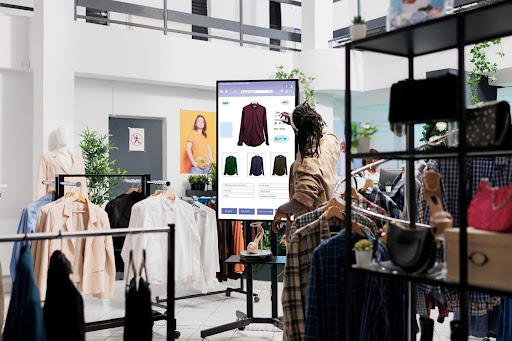
The retail sector is experiencing significant change, largely due to the swift rise in IoT (Internet of Things) applications. These technologies, encompassing a web of interconnected devices, sensors, and software, exchange data online to streamline store operations, boost shopper satisfaction, and secure a market advantage.
Grand View Research highlights that the IoT’s role in retail, valued at $42.38 billion in 2022, is on a trajectory to expand at a 28.4% CAGR between 2023 and 2030. This growth is spurred by the demand for advanced solutions in inventory management, customer insights, theft prevention, supply chain efficiency, and automated shopping environments.
This blog post delves into how cutting-edge IoT strategies are revolutionizing retail, enhancing business outcomes and elevating customer experiences. We’ll examine both the hurdles and the breakthroughs in retail IoT, alongside forecasting trends that are set to redefine the industry’s future.
The Role of IoT in Reinventing Retail Operations
The introduction of IoT (Internet of Things) technologies is revolutionizing the retail sector by enhancing various aspects of operations such as inventory management, checkout procedures, and overall customer experience. Here’s a closer look at how IoT is making a significant impact in the retail world with some engaging examples to highlight its importance.
Efficient Inventory Management
One of the persistent issues for retailers involves maintaining the perfect inventory balance – avoiding too little or too much stock while also minimizing loss and waste. IoT tools like RFID tags, sensors, and intelligent shelving units empower retailers to keep an eye on their inventory with real-time precision. This ensures stock levels, locations, and conditions are always known, leading to improved inventory accuracy, reduced labor costs, and better supply chain efficiency. A prime example is Amazon Go, which leverages IoT solutions to automate store operations and eliminate the need for traditional checkout encounters.
Checkout Automation and In-Store Efficiency
IoT shines in enhancing the checkout process and in-store operations too. By employing technologies like cameras, sensors, and mobile applications, retailers can offer customers a seamless way to scan and pay for their items bypassing any queues or cashier interactions. This streamlining of the payment process not only boosts customer satisfaction and loyalty but also allows staff to redirect their focus toward more impactful tasks. A case in point is Walmart’s adoption of scan-and-go technology, enabling customers to use their smartphones for a faster checkout experience. With the partnership with Vusion, they are transforming Walmart stores with IoT technology by introducing IoT into cloud for retail ventures.They are a front-runner in providing IoT solutions tailored for the retail industry.
Enhancing the Customer Experience with Personalization
Beyond operational efficiencies, IoT stands out for its capacity to elevate the customer experience through personalization. By collecting and analyzing data from IoT devices like beacons, sensors, and wearable technology, retailers can gain deep insights into consumer behaviors, preferences, and demands. This wealth of information enables businesses to customize their offerings, marketing efforts, and services to meet the unique needs of each customer, thereby fostering a more engaging and personalized shopping experience. Starbucks, for example, connects its mobile app, loyalty scheme, and coffee machines with IoT devices to offer customized recommendations and rewards, making each visit more personal for its customers.
Future Trends: The Next Frontier in Retail IoT
The retail sector is in a constant state of flux, continually adapting to the latest technologies and shifting consumer expectations. Amidst this sea of change, the Internet of Things (IoT) stands out as a pivotal force of transformation. This section is dedicated to examining the emerging trends poised to reshape the landscape of retail through IoT, offering both fresh opportunities and new challenges for both retailers and their clientele.
Artificial Intelligence and Machine Learning Integration
Artificial Intelligence (AI) and Machine Learning (ML) are set to supercharge the IoT space within retail, transforming the immense data streams from IoT devices into actionable insights, forecasts, and personalized recommendations. This duo can significantly refine operational efficiency, enhance the consumer experience, and elevate overall business outcomes. For instance, AI and ML are revolutionizing inventory management, streamlining checkout operations, tailoring marketing efforts, and fortifying security against fraud. Nonetheless, their deployment brings to light considerations around data integrity, security, privacy, and ethical usage, necessitating thoughtful navigation by both retailers and regulatory bodies.
Augmented Reality for Experiential Shopping
Augmented Reality (AR) promises to revolutionize the shopping experience by melding digital elements with the physical realm. AR offers customers novel, interactive ways to explore, evaluate, and purchase products, whether in-store or from the comfort of their homes. For instance, with AR, shoppers can envision how items might look in their personal spaces—be it furniture, apparel, or makeup—and receive customized advice and insights. For retailers, AR is a powerful tool to showcase their offerings, captivate shoppers, and drive both sales and customer loyalty. Nevertheless, realizing AR’s full potential requires high-caliber content, intuitive interfaces, and consistent connectivity for an unmatched experiential journey
And if you like to dive into the newest retail technology, find here further information.
